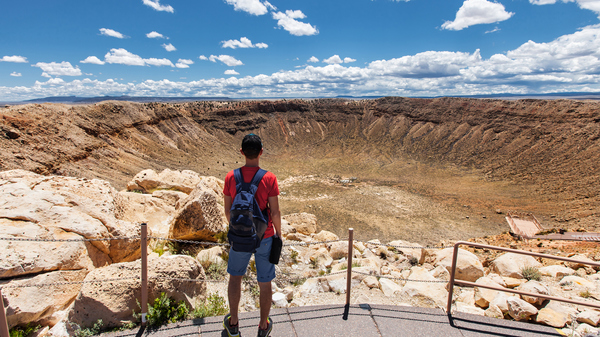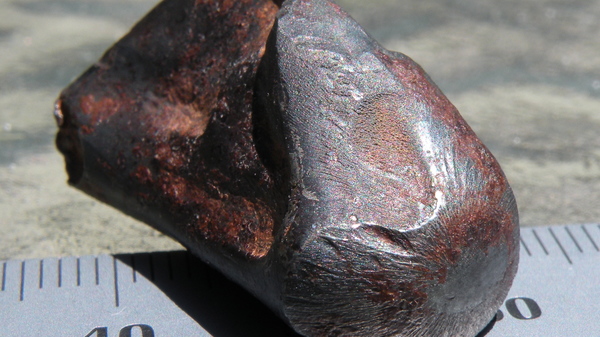A Beginner’s Guide to Meteorite Hunting
Space rocks burn through our atmosphere every hour of the day. The bits that survive the plunge usually splash into the oceans, but with a little knowledge, a lot of hard work, and a bit of luck, you can find meteorites on land.

Finding meteorites takes good luck, the right gear, and a solid understanding of where to look.
©iStockphoto.com/Nikolas_jkd
What’s Left After the Burn
A meteorite is what remains of a space rock that has burned through our atmosphere, usually consisting of about five percent of the original meteoroid.
Three Things to Look For
Before you set out to hunt for a piece of alien geology, ask if you can keep what you find. The answer can depend on where you search. Space rocks recovered in US National Parks, for example, belong to the federal government. But if you can own the sample, you may be in luck; some meteorites have fetched prices up to $1,000 per gram from collectors.
Here are three basic characteristics to help you identify a meteorite:
1. Look for stones that range in size from a pebble to a fist and have a slightly shiny, burned appearance as a tell-tale sign of a scorching journey through the atmosphere. This patina is known as a “fusion crust” and will be most evident on recently-arrived meteorites.
2. If they contain a lot of iron, a magnet will stick to them.
3. Meteorites should be significantly heavier than typical Earth rocks for their size.

Meteorites often display a dark “fusion patina” as a sign of their trip through our atmosphere.
Photograph by Meteoritekid / CC BY-SA 4.0
Where to Search?
Extraterrestrial material can land anywhere around the world, but if you have an unlimited budget, a quick trip to Antarctica would be ideal.
Why such extreme terrain? It can be hard to identify an alien stone in most places, so you’re much more likely to pick one out where there aren´t many other stones on the ground, like deserts or icy tundra. “Meteorites fall anywhere, but they are easiest to spot where there are few terrestrial rocks,” said geochemist Alan Rubin in an interview with Scientific American.
That’s why more meteorites have been discovered in Antarctica than in any other region.
Dry Lake Beds and Deserts
Short of an expensive meteorite safari to the South Pole, you should seek outexposed, open places on Earth’s surface, like deserts or dry lake beds, for the best chance of success. In that landscape, you can be guided by color, as most meteorites are blackish – and that makes them easier to spot in an area dominated by lighter-hued stones.
There’s another reason dry conditions are good for meteorite hunters – the less water present, the better-preserved an alien stone will be. Some experienced collectors also search for reports of recent meteorite impacts and focus on a specific area to try to gather recent arrivals. And many recommend a good metal detector to help identify stones with a high metallic content.
While hunting in lake beds and deserts raises the odds that you may come across a piece of space debris, you can certainly search for meteorites anywhere on Earth, since space rocks crash to the surface in every part of the globe.
Ask the Right Questions
So let’s say you´ve found a stone you think may be from space. Here are some questions to ask next:
Does it lack pores? Is it dense? More dense than nearby rocks?
Is it magnetic?
If part of the interior is exposed, does it display a shiny silver-metallic color?
If the answer to all of the above is yes, you may have found something from space. Take it to an expert for evaluation. The Geological Survey of your local government, or the Geology department of a nearby university are good places to ask for resources.
The Huge World of Micrometeorites
But you may not have to travel far to encounter traces of deep space. There is one class of cosmic material that can be as close as your own roof.
Until recently, tiny bits of alien stone were not considered important enough to study. But Jon Larsen, a jazz musician and amateur scientist based in Norway, made a discovery one morning in 2009 that opened a window on the fascinating hidden world of micrometeorites.
“A shiny black dot suddenly appeared on my white veranda table while I was having strawberries for breakfast. It triggered my curiosity big time...”, he told the BBC in 2022.
So he got to work, collecting and classifying intriguing samples of tiny material from urban rooftops and partnering with John Kihle, a mineralogist at the University of Oslo, to verify that these minuscule bits of minerals were indeed dust from space.
Carrying Secrets from the Void
Today, Larsen has collected thousands of samples, and is convinced these bits of space geology can tell us something about the history of the universe.
“Cosmic dust particles, the oldest solid matter there is, [is] ‘ash’ from dead stars,” Larsen said in a 2021 interview with ThisColossal.com. “Nothing has traveled farther…The search/hunt for stardust continues in all directions, but I am particularly interested in the unmelted ones, which contain water and complex organic molecules, [the] building blocks of life.”
Where do these micrometeorites come from? Some scientists think they originate from the asteroid belt between Mars and Jupiter, while others believe they may come from further out, beyond Neptune, perhaps from the Kuiper Belt and the Oort Cloud. What is known is that some contain grains of material that pre-date our Sun, providing a possible window to the history of our solar system.